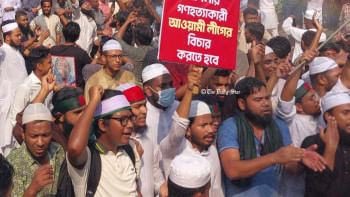What should Bangladesh expect?
We shall heartily welcome India's Minister for External Affairs Ms. Sushma Swaraj to Dhaka on June 25, when she comes for a two-day visit. Ms. Swaraj is not unknown to the people of Bangladesh, who recall the supportive role she played even when she was young during our Liberation War in 1971.
She has been elected seven times as a Member of Parliament and three times as a Member of the Legislative Assembly. At the age of 25, she became Haryana's youngest cabinet minister and has also served as chief minister of Delhi.
The visit is important for several reasons. The fact that Ms. Swaraj is visiting Bangladesh as her first foreign trip shows the importance the Modi government attaches to relations with Bangladesh. Secondly, the minister's visit is taking place without preparatory talks at the foreign secretary's level, which implies that the issues with Bangladesh are well-known. Thirdly, Modi chose Bhutan for his first foreign trip on June 15, where he also spoke about improving relations with all of India's neighbours, and the foreign minister's visit to Bangladesh is in line with this policy.
Although the last five years saw bilateral relations reach a new productive trajectory in many sectors, Teesta water-sharing treaty, ratification of the Land Boundary Agreement (LBA) and killing or kidnapping of Bangladeshi nationals are the major unresolved issues. Signing of the Teesta treaty and LBA was held back during the Congress-led government because it was a weak government, and did not have a majority in the Rajya Sabha (Upper House). This time around, with a strong Modi government with overwhelming majority, a resolution of these issues will hopefully be found as they a have direct and visible impact on the people of Bangladesh.
The Modi government's agenda appears to be (a) to get transit facility through Bangladesh for various end-points and (b) Bangladesh soil should not be used for training, sanctuary and other operations by domestic or foreign militant and insurgent organisations.
The transit issue has to be examined against the infrastructure capacity in Bangladesh covering all modes of transport -- roads, railways, waterways, river ports and sea.
It is important to recognise that the Bangladesh road network is relatively less developed compared to India's. Local transport experts say that Bangladesh national highways are all 2-lanes (some of them are being turned to 4-lanes) and extensively used. These highways were built based on an axle-load limit of 8.2 tons compared to 10.2 or more tons axle load limit in India. Again, most of the trucks used in India have 2-axles and these are highly loaded, As such, they argue that it will not be desirable to allow these overloaded vehicles to move now along Bangladesh highways. On the transit issue, local experts argue that railway, river route and sea route could preferably be considered.
Furthermore, India wants transit facility bilaterally with Bangladesh while Bangladesh wants sub-regional transit rights through India to Nepal and Bhutan from and to Bangladesh in accordance with the 2011 Indo-Bangladesh Framework Agreement on Cooperation and Development. There were meetings on this issue but nothing concrete has come out.
In order to make progress in the area of regional cooperation in transport, the governments of India, Nepal and Bhutan individually and jointly may consider adopting bilateral/multilateral road /rail transport agreements for movement of goods to each other's country. Furthermore, all governments may agree to upgrade the access roads to all major land ports and national highways to regional standards, and establish modern facilities for loading and unloading cargo, and to build warehouses for storage. Obviously, this will take time but if all the governments agree now, the process of regional transport cooperation will commence.
Although, since 2009, the Bangladesh government has been determined to root out all militant /extremist organisations from the soil of Bangladesh, BSF of India recently alleged that there are 45 North-East militant camps in Bangladesh. If the allegation is correct, this is disturbing news for Bangladesh and India.
During Modi's election campaign, the issue of “infiltration and illegal immigrants” from Bangladesh came to the fore. The Narendra Modi government reportedly will also complete all pending fencing work along the northeast border with Bangladesh. There is a lurking suspicion that the Modi government may link the “issue of infiltration and illegal immigrants” from Bangladesh with the ratification of LBA. If it is raised, this will be a totally a new and uncomfortable issue for Bangladesh.
The relationship is not restricted to only between governments but exists between the people of the two countries independently of the policies of the governments because of the ties of history and culture. Therefore, the Modi government may not raise any issue which perturbs Bangladesh people because people to people relations are the foundations of friendship and goodwill to each other.
If the majority of the people of Bangladesh are disappointed or annoyed with the perceived “arrogance” or “highhandedness” of the Modi government, the Bangladesh government may not get support from its people to meet an Indian request for any facility because bilateral relation should be a two-way street, not a one-way street.
Bangladesh-India relations are complex, sensitive and multi-dimensional. Good relations cannot be imposed because they are built on principles of fairness and justice. Mutual respect is created when an issue is resolved with sensitivity to each other's interests. A larger neighbour has certain responsibilities to lead the way for its smaller neighbours. It is hoped the visit of the Indian external affairs minister will generate such regional spirit of cooperation.
The writer is a former Bangladesh Ambassador to the UN, Geneva.

 For all latest news, follow The Daily Star's Google News channel.
For all latest news, follow The Daily Star's Google News channel. 



Comments